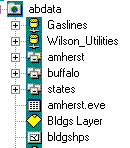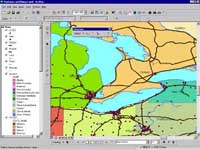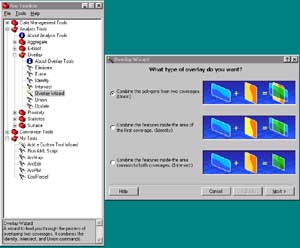|
ArcInfo Version 8 takes GIS into the next millennium. Improvements in technology call for more advanced GIS capabilities,
and ArcInfo Version 8 answers that need with three new applications--Arc Catalog, Arc Toolbox, and Arc Map. Version 8
is the first release of Esri's next generation of software architecture that will unify Esri software into a more tightly integrated
family.
What's in ArcInfo Version 8?
ArcInfo Version 8 contains the same core applications as Version 7.x. These application--ARC, ARCPLOT, and ARCEDIT--
have been enhanced and updated. This ensures binary compatibility with any application developed using Version 7.x. Three new
applications, Arc Toolbox, Arc Catalog, and Arc Map, provide easy-to-use, Windows-style user interfaces that make working with
ArcInfo easier than ever before. The new component object data model introduced in Version 8 goes beyond traditional point, line,
and polygon features and allows modeling of objects, such as power poles and electrical switches, in a more realistic way. These new
applications are highly customizable.
Making ARC Functions Easier with Arc Toolbox
Arc Toolbox contains over 140 geoprocessing tools presented as wizards and menu choices. Though most of these functions exist
at the ARC command line, Arc Toolbox makes using them easier and more manageable. Arc Toolbox is organized into four main
categories: Data Management Tools, Analysis Tools, Conversion Tools, and My Tools. An example of one of these tools is the
overlay wizard, which steps the user through the process of setting up and running the UNION, INTERSECT, or IDENTITY
commands on coverages that are selected by browsing or by dragging and dropping a selection from Arc Catalog.
Arc Toolbox streamlines and simplifies many of the complex geoprocessing tasks previously done at the ARC command line.
Arc Toolbox can establish a client/server relationship connection over a TCP/IP network so that jobs can be sent out to run at a
specified time on a server, allowing the user to continue working without delay. Other features of Arc Toolbox include the
to set up batch processing jobs, run AML scripts, and add custom tools.
Managing Data with Arc Catalog
Arc Catalog is the GIS data management tool in ArcInfo Version 8.
 Without having to start a separate application, data can
be investigated. Arc Catalog has two primary visual components--a tree view that displays the list of available folders and a
views panel that provides four different methods of examining data. Folders containing GIS data sets carry a special icon. Arc Catalog
identifies different feature data sets, such as coverages, shapefiles, raster files, and Spatial Database Engine (SDE) databases, with
a unique icon for each that makes it easy to locate specific data sets. This means less time spent finding and organizing data and
more time spent using data to create maps or perform analyses.
Without having to start a separate application, data can
be investigated. Arc Catalog has two primary visual components--a tree view that displays the list of available folders and a
views panel that provides four different methods of examining data. Folders containing GIS data sets carry a special icon. Arc Catalog
identifies different feature data sets, such as coverages, shapefiles, raster files, and Spatial Database Engine (SDE) databases, with
a unique icon for each that makes it easy to locate specific data sets. This means less time spent finding and organizing data and
more time spent using data to create maps or perform analyses.
The views panel displays selected items in the tree view. Tabs at the top of the views panel let users inspect the items in four
different way--in contents, thumbnail, documentation, and preview modes. Selecting the contents view shows the feature data
sets in a selected workspace or SDE database; the feature classes in a coverage; or the attribute items in a feature class, shapefile,
or INFO table. The thumbnail view displays a graphical preview of a data set. These thumbnails are generated automatically for
some data sets and can be created within Arc Catalog for other data sets. The documentation view lets the user create and display
documentation (i.e., metadata) about the selected data set using Extended Markup Language (XML). XML documentation schemata
can be built to conform to organizational documentation standards. Preview mode displays the selected data set and provides tools
for zooming and panning.
The look and behavior of Arc Catalog can be tailored to individual or organizational needs. Arc Catalog can also be included
as a component in a custom application. Customization of all the new applications is discussed later in this article.
Mapping and Editing in Arc
ArcInfo users can think of Arc Map as an amalgamation of ARCEDIT and ARCPLOT that can be used for the bulk of their editing
and mapping tasks. New CAD-like construction tools and intelligent map generation tools make it a powerful and easy-to-use
application.
The Data View and the Layout View provide two ways to view data in Arc Map. In the Data View users interact with the map without
being concerned about page elements such as north arrows. The Layout View is a virtual page that includes cartographic elements
and also shows all the data in data frames. Almost everything that can be done to data in the Data View can also be done in the
Layout View. Right clicking on a data frame activates it, allowing the data inside to be manipulated. Both Data View and Layout
View use the Table of Contents (TOC) to manage data. The TOC provides a legend-like display for the data sets in the map.
The appearance of data sets can be changed through the TOC.
The TOC is also the interface to the layers of a map.
 Adding data to the Data View creates a layer for that data. A layer is not a copy
of the data; it is a reference to the data. Layers contain information describing how the data should be drawn. Each layer can be
assigned specific drawing characteristics. For example, a parcel coverage that is used by several groups within a planning department
can have a layer made for each group. Each group can symbolize the layer its own way. Using layers, GIS managers or mapmakers
can set up specific views of a data set that can be used for a mapmaking session. Data managers can protect the integrity of the
original data set by allowing users to access only specific layers.
Adding data to the Data View creates a layer for that data. A layer is not a copy
of the data; it is a reference to the data. Layers contain information describing how the data should be drawn. Each layer can be
assigned specific drawing characteristics. For example, a parcel coverage that is used by several groups within a planning department
can have a layer made for each group. Each group can symbolize the layer its own way. Using layers, GIS managers or mapmakers
can set up specific views of a data set that can be used for a mapmaking session. Data managers can protect the integrity of the
original data set by allowing users to access only specific layers.
Data can be added to Arc Map by dragging and dropping it from Arc Catalog, by using the Add Data button on the Arc Map
interface, or by right clicking on the TOC to bring up a context menu and using the Add Data option. The Add Data dialog,
a lightweight version of the same dialog in Arc Catalog, illustrates the consistent interface design of these tools. Any of these
methods of adding data will allow inclusion of all or selected portions of a data set. An entire coverage with all feature classes
or just the lines and tics or specific feature classes from different data sets can be added--all at the same time. This simplifies
and speeds up map creation.
Each data set becomes a layer in the TOC with a set of properties that defines how it is drawn, its name, its projection, and how
it should be labeled. Right clicking on any layer and choosing Properties from the context menu will invoke a property sheet
menu with several options. From this menu, the user can change the way a layer is drawn, choosing from various types of thematic
mapping, classification methods, ramp colors, and symbols. The labeling property sets label characteristics, such as use of halos
and masks, and the expressions used to label features.
Arc Map Toolbars
Arc Map provides data editing and manipulation tools in nine distinct toolbars that can be added to the interface. Users can also
create and add custom toolbars. The standard toolbars available in Arc Map are listed in Table 1.
Users can create, modify, and delete data as well as perform many other functions using the Editor toolbar. It offers more CAD-like
functionality than previous versions of ArcInfo and allows precise adjustments and additions to data. Editor employs the concept
of an edit sketch.
 The user digitizes a sketch of the points or vertices that make up a new feature. Once the process of edit sketch is
started, the user can choose another command tool or perform another operation and then resume editing the sketch right where
editing previously stopped. New construction tools allow the addition of features parallel or perpendicular to any other feature
present on the map, and segments can be constrained to a specific length, radius, angle, or deflection angle. True curves,
a much-requested feature, are available in Version 8 and can be created, edited, and maintained in Editor.
The user digitizes a sketch of the points or vertices that make up a new feature. Once the process of edit sketch is
started, the user can choose another command tool or perform another operation and then resume editing the sketch right where
editing previously stopped. New construction tools allow the addition of features parallel or perpendicular to any other feature
present on the map, and segments can be constrained to a specific length, radius, angle, or deflection angle. True curves,
a much-requested feature, are available in Version 8 and can be created, edited, and maintained in Editor.
Editor also employs the concept of an edit task. Examples of edit tasks would be such activities as creating a new feature or extending
or trimming a feature. Many other tools and functions are available in Editor.
In Editor, all map layers can be edited at the same time. Selecting a feature or group of features by dragging out a box on the display
selects all the features within that box whether they are power poles, building footprints, or street casings. The user has control over
this environment and can set properties for each layer to allow editing or just display.
Customizing New Version 8 Applications
Customizing these new applications is easy. The interface can be customized by simply adding a toolbar or dragging a command
button from one toolbar to another. Arc Map and Arc Catalog have a Tools menu with a Customize option that allows easy
modification of buttons and other tools on the interface without any programming.
The underlying foundation of Arc Catalog and Arc Map is Microsoft's Component Object Model (COM). COM is a coding standard
for creating components and building applications from those components. It allows components to plug into other applications
that support COM. For example, Visual Basic for Applications (VBA) is part of Arc Map and Arc Catalog. The VBA editor inside
each of these applications lets users write custom scripts and run them as macros or save them in separate command buttons that
can be added to the application interface. Customizations can be made outside Arc Map and Arc Catalog using development
languages that support COM such as Visual C++, Delphi, or Java.
Customizing Arc Toolbox is slightly different. Arc Toolbox is an Open Development Environment (ODE) application built with
Visual Basic (VB) 6.0. It can be configured to display only some of its tools, add custom tools, run AML scripts, or start other
applications such as ARCEDIT, ARCGRID, Arc Catalog, or any other DLL or EXE program.
Modernizing GIS Applications
ArcInfo Version 8 will help modernize GIS applications and expand their use. Version 8 provides more powerful tools,
a more flexible data model, and a strong customizable environment. The suite of tools and applications in ArcInfo Version 8
makes GIS easier and more powerful than ever.
| 
